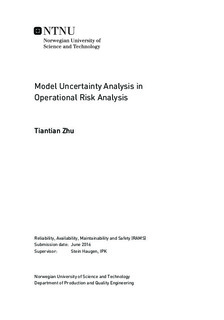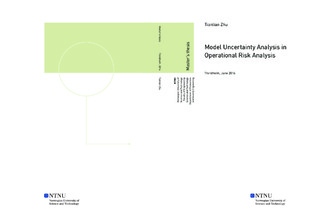| dc.description.abstract | A model is a simplified representation of the real world. Model uncertainty is a common issue in predictive models, and discussions on this can be found in many subjects. Model uncertainty is a branch of uncertainty analysis and is widely discussed, but in reality uncertainty analysis mainly focuses parameter uncertainty.
An overview of uncertainty is established by reviewing different definitions of uncertainty in various applications, three dimensions, classifications, representations of uncertainty and relations between uncertainty and risk for decision making. There are different understandings and definitions regarding uncertainty and model uncertainty in varied fields. Own definitions of these terms must be clearly stated and be meaningful for the problem at hand. Definitions about uncertainty and model uncertainty, which apply in this thesis, are given to avoid ambiguity and limit topic range.
"Model Uncertainty" is sometimes used about "Model Output Uncertainty" which in some published works are an integrated result from all kinds of uncertainty. Conceptual uncertainty, model error, model structure uncertainty, modelling uncertainty are used in some papers. Being cautious is necessary when dealing with these terms. An uniformation of these terms can better scientific communication and the application of outcomes.
A general and systematic modelling process is described to see how model uncertainty can be analyzed using a systematic model development process as a starting point. Proposed probabilistic models, relevant modelling techniques, and a modelling process for operational risk analysis are described. This part contributes to form the main concept of analysing model uncertainty in this thesis.
Methods to deal with model uncertainty are identified and described by reviewing relevant application fields, including probabilistic risk analysis used in the Nuclear Power Sector, Environmental modelling, and Computational Modelling and Simulation. There are different characterization methods for model uncertainty. Methods about model uncertainty resources identification, characterization and analytical treatment, and model uncertainty reduction are simply summarised.
These methods for model uncertainty treatment can be concluded to three groups. "Input-Driven", "Output-Driven", and Hybrid. "Input-driven" methods provide a better understanding of the impact of identified model uncertainty sources. They are mainly qualitative methods. "Output-driven" methods provide a "closer" result to "truth" of the model outputs.
Besides, a method for systematic model uncertainty sources identification is proposed. This method is based on the systematic modelling process described in the previous chapter. A fish bone diagram showing model uncertainty sources, which might occur at each modelling step, is presented.
Proposed method for model uncertainty identification is applied to identify model uncertainty sources in MIRMAP model. Further applications of the identification information are also described. Proposed method for model uncertainty sources identification is a systematic, easy and applicable method and it is verified by its application in MIRMAP model. It is very suitable for big and hierarchical models, and it do opens for further improvement to be made.
Identified model uncertainty sources in MIRMAP model are mainly in following groups: Limitation and scope of analysis, ignored dependence, ignored sub-barrier system or components, surrogate values are used as model inputs (e.g industrial average values are used for plant specific values), simplification of system and assumption in model structure from event tree to BBN, descritization and approximation in numerical solution. Different model uncertainty sources have varied-degree impact on the model outputs. Characterization methods for these model uncertainty sources should vary according to the importance, location and cause of these model uncertainty sources. | |

